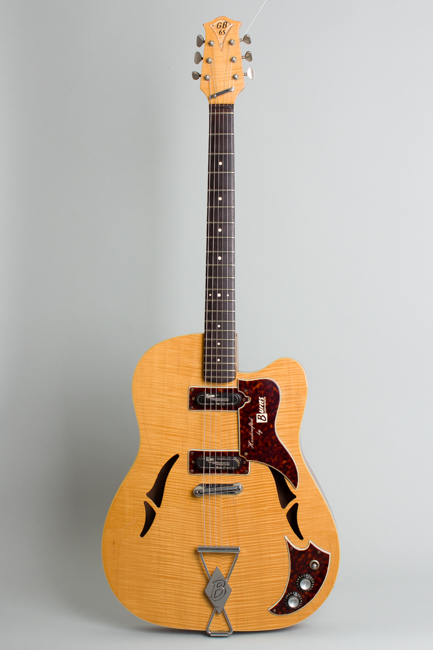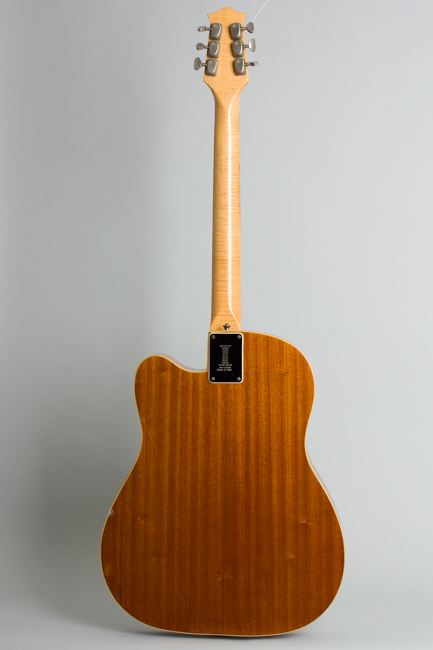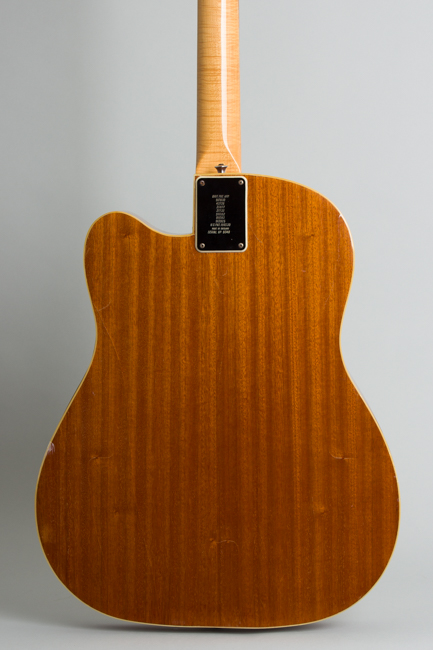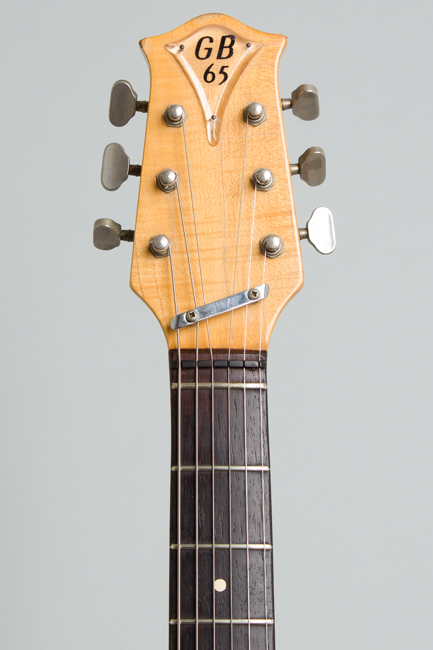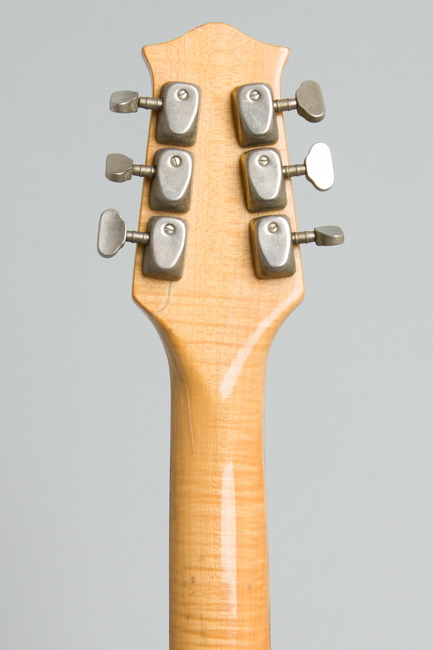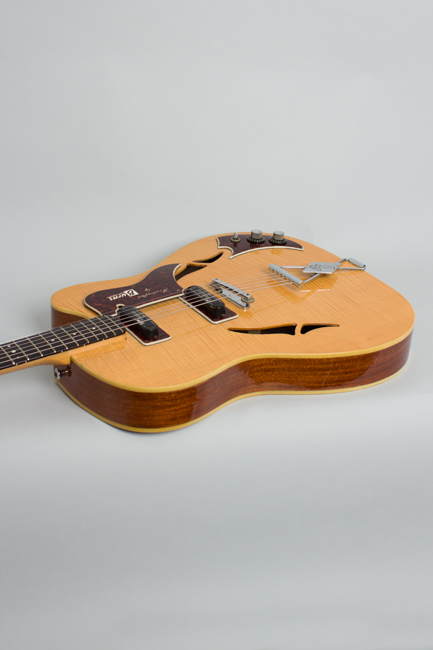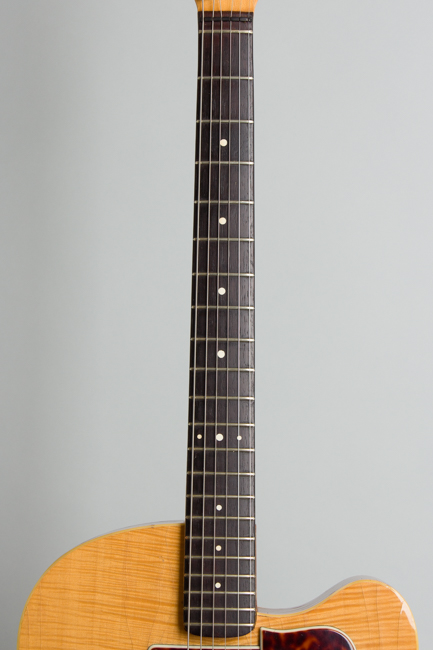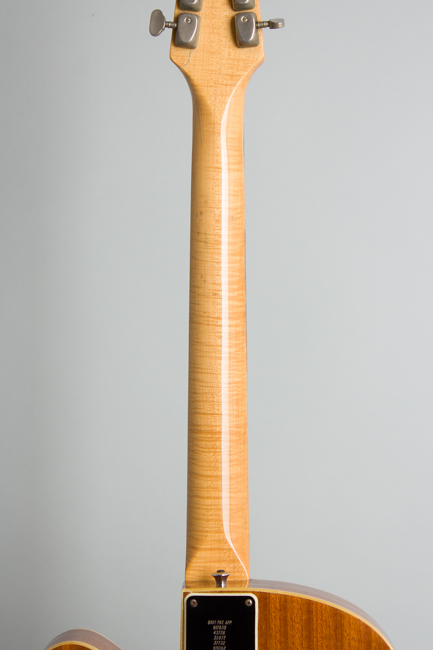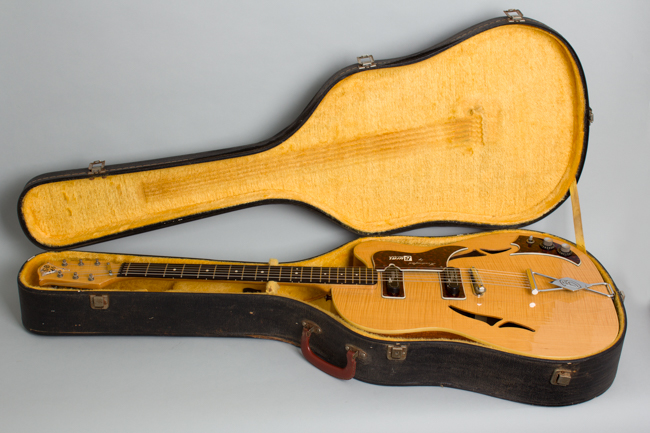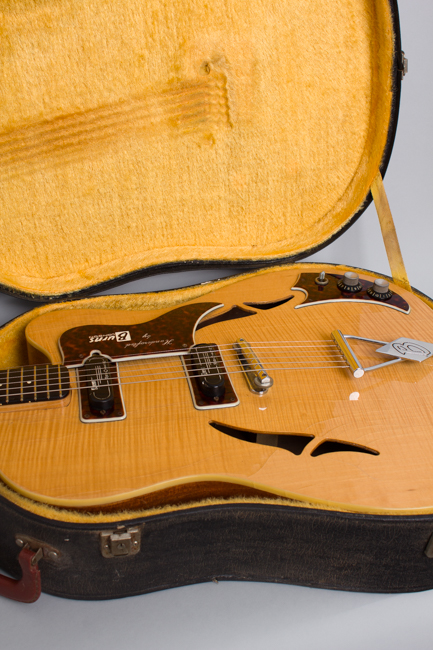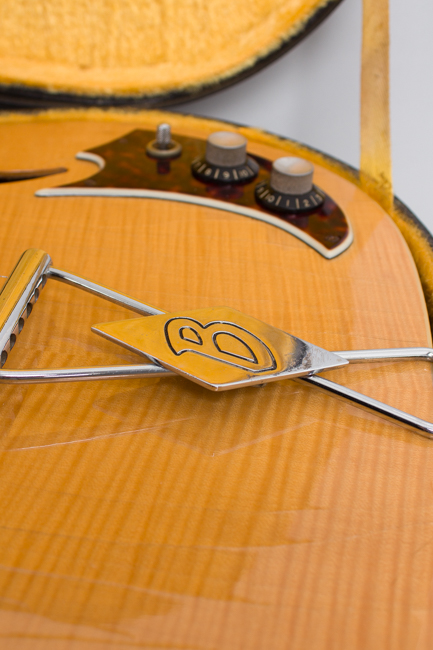Burns GB 65 Semi-Hollow Body Electric Guitar (1965)
This item is currently on hold.
Item # 12187
Prices subject to change without notice.
Burns GB 65 Model Semi-Hollow Body Electric Guitar (1965), made in London, England, serial # 9340, natural polyester finish, laminated mahogany body, flamed sycamore top, maple neck with rosewood fingerboard, black hard shell case.
This is one of the rarest and most unusual of the original English-made Burns guitars: the GB65, an eccentric but certainly original design. The GB-65 is a flat-topped hollow body electric with two pickups, eccentrically shaped soundholes and a long 25 1/2" scale neck. The laminated mahogany body has a clear-finished "flamed sycamore" top, in this case beautifully grained, and a single rounded cutaway. It is 16 1/2" wide and a full 2 5/8" deep. The top sports twin eccentrically shaped 2-part soundholes and an almost Gaudi-esque fluid pickguard and control plate made of thick tortoise celluloid. It is fitted with a trapeze tailpiece with a "B" logo centerplate and a simple metal bar floating bridge.
The long-scale neck (unusual on a Burns) is fitted with an unbound, dot inlaid rosewood fingerboard and carries the same simple truss rod as the budget Nu-Sonic, not the elaborate Burns gearbox. The flat-cut headstock has no back-angle or scroll so needs a string tensioner behind the nut. It is a typical Burns contour, with a round profile just hinting at a dressed-away "V".
Despite its acoustic look, the GB65 has a fully realized electric sound capable of surprisingly bright tones...especially compared to the usual amplified flat-top. "Specially developed Rez-O-Matic pickups are used" claimed Burns although the units actually resemble the simple Nu-Sonic pickups. The controls are simple; a 3-way switch and volume and tone knobs, the latter only working on the neck pickup (another Burns eccentricity).
Burns (fully schooled in the art of snazzy slogans) promoted the body design as "Controlled Resonance" which in this case seems to consist of a solid block of wood glued under the bridge! The design does work, to an extent; at high volume it will feed back, but far less than the likes of say an ES-330. This concept was further developed with the better known "Virginian" model using the same body framework with a round soundhole introduced later in 1965.
The GB65 was in limited production for just over a year from early 1965 into mid-'66, one of the first instruments axed by Baldwin after they took over in late 1965. It appears only a couple of production batches were completed, with existing instruments straddling the Burns/Baldwin line. They appear somewhat randomly with either logo, the only physical difference being the engraving on the pickguard; this Burns-logo GB65 is the rarer version. Jim Burns seemed proud of this creation, which was unlike most guitars in existence in 1965. It is a large guitar but handles well and the sound is quite bright and clear for a full-size hollow instrument. While the GB 65 appears to be an evolutionary dead end, we can't help but notice the similarity of the Taylor electrics introduced a decade or so ago.
Overall length is 42 1/2 in. (108 cm.), 16 3/8 in. (41.6 cm.) wide at lower bout, and 2 1/2 in. (6.4 cm.) in depth, measured at side of rim. Scale length is 25 1/2 in. (648 mm.). Width of nut is 1 3/4 in. (44 mm.).
Overall this is a decently preserved and a fine playing example of this rare burns creation. It shows heavy finish checking typical of many of these polyester-finished Baldwin-era Burns instruments. This is visible on all surfaces but heaviest on the headstock whare some finish has begun to pull away from the wood in spots. There are some small areas flaked off along the edges of the fingerboard but nothing that impedes play. There are only very minor dings and dents to the finish beyond this.
All hardware is original and complete, mostly relatively clean. The exception with some noticeable wear through the plastic on the top edges of the bridge pickup, another common situation among Burns instruments using this style pickup. The only alteration is a small metal disk added to re-inforce the jack on the side, likely over a small crack in the rim. This guitar plays and sounds excellent and is a surprisingly good-feeling and interesting-sounding instrument, eccentric as all get-out but a solid design nonetheless. It resides in a somewhat flimsy but functional 1970s Epiphone HSC. Overall Very Good + Condition.
This is one of the rarest and most unusual of the original English-made Burns guitars: the GB65, an eccentric but certainly original design. The GB-65 is a flat-topped hollow body electric with two pickups, eccentrically shaped soundholes and a long 25 1/2" scale neck. The laminated mahogany body has a clear-finished "flamed sycamore" top, in this case beautifully grained, and a single rounded cutaway. It is 16 1/2" wide and a full 2 5/8" deep. The top sports twin eccentrically shaped 2-part soundholes and an almost Gaudi-esque fluid pickguard and control plate made of thick tortoise celluloid. It is fitted with a trapeze tailpiece with a "B" logo centerplate and a simple metal bar floating bridge.
The long-scale neck (unusual on a Burns) is fitted with an unbound, dot inlaid rosewood fingerboard and carries the same simple truss rod as the budget Nu-Sonic, not the elaborate Burns gearbox. The flat-cut headstock has no back-angle or scroll so needs a string tensioner behind the nut. It is a typical Burns contour, with a round profile just hinting at a dressed-away "V".
Despite its acoustic look, the GB65 has a fully realized electric sound capable of surprisingly bright tones...especially compared to the usual amplified flat-top. "Specially developed Rez-O-Matic pickups are used" claimed Burns although the units actually resemble the simple Nu-Sonic pickups. The controls are simple; a 3-way switch and volume and tone knobs, the latter only working on the neck pickup (another Burns eccentricity).
Burns (fully schooled in the art of snazzy slogans) promoted the body design as "Controlled Resonance" which in this case seems to consist of a solid block of wood glued under the bridge! The design does work, to an extent; at high volume it will feed back, but far less than the likes of say an ES-330. This concept was further developed with the better known "Virginian" model using the same body framework with a round soundhole introduced later in 1965.
The GB65 was in limited production for just over a year from early 1965 into mid-'66, one of the first instruments axed by Baldwin after they took over in late 1965. It appears only a couple of production batches were completed, with existing instruments straddling the Burns/Baldwin line. They appear somewhat randomly with either logo, the only physical difference being the engraving on the pickguard; this Burns-logo GB65 is the rarer version. Jim Burns seemed proud of this creation, which was unlike most guitars in existence in 1965. It is a large guitar but handles well and the sound is quite bright and clear for a full-size hollow instrument. While the GB 65 appears to be an evolutionary dead end, we can't help but notice the similarity of the Taylor electrics introduced a decade or so ago.
Overall length is 42 1/2 in. (108 cm.), 16 3/8 in. (41.6 cm.) wide at lower bout, and 2 1/2 in. (6.4 cm.) in depth, measured at side of rim. Scale length is 25 1/2 in. (648 mm.). Width of nut is 1 3/4 in. (44 mm.).
Overall this is a decently preserved and a fine playing example of this rare burns creation. It shows heavy finish checking typical of many of these polyester-finished Baldwin-era Burns instruments. This is visible on all surfaces but heaviest on the headstock whare some finish has begun to pull away from the wood in spots. There are some small areas flaked off along the edges of the fingerboard but nothing that impedes play. There are only very minor dings and dents to the finish beyond this.
All hardware is original and complete, mostly relatively clean. The exception with some noticeable wear through the plastic on the top edges of the bridge pickup, another common situation among Burns instruments using this style pickup. The only alteration is a small metal disk added to re-inforce the jack on the side, likely over a small crack in the rim. This guitar plays and sounds excellent and is a surprisingly good-feeling and interesting-sounding instrument, eccentric as all get-out but a solid design nonetheless. It resides in a somewhat flimsy but functional 1970s Epiphone HSC. Overall Very Good + Condition.
